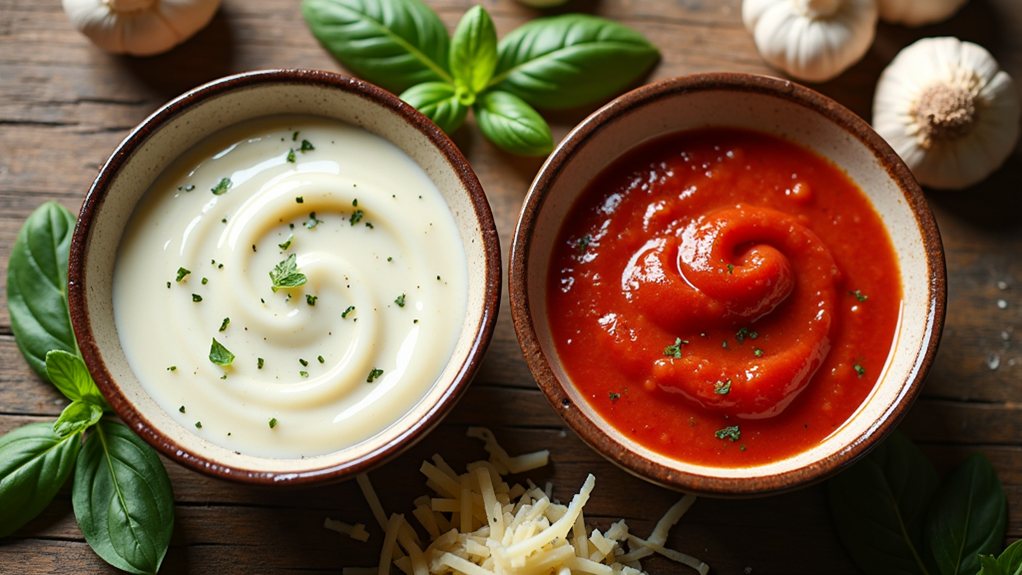The secret to exceptional homemade pizza lies not in the dough or toppings, but in the sauce that ties everything together. From the slow-simmered richness of a Classic New York Red to the bright simplicity of Neapolitan tomato sauce, each variation brings its own character to the pie. While traditional recipes remain beloved staples, modern interpretations like white sauce and pesto open up new possibilities for creative pizza-making adventures.
The Art of Homemade Pizza Sauce Making

Making pizza sauce from scratch stands as one of the most rewarding aspects of home pizza-making, offering countless possibilities for customization and flavor exploration.
The art of crafting homemade pizza sauce opens doors to endless creativity, allowing each chef to discover their perfect blend.
From classic New York-style red sauce to creamy white variations, each preparation method brings its own character to the final dish.
The key to creating exceptional pizza sauce lies in selecting quality ingredients and understanding basic flavor principles.
While traditional recipes provide reliable starting points, home cooks can experiment with herbs, spices, and cooking techniques to develop their signature sauces.
Whether simmered slowly or quickly blended, these fundamental components transform ordinary pizzas into personalized culinary creations.
Blanching and peeling tomatoes creates the smoothest base for an exceptional sauce texture.
Classic New York Red Sauce Recipe
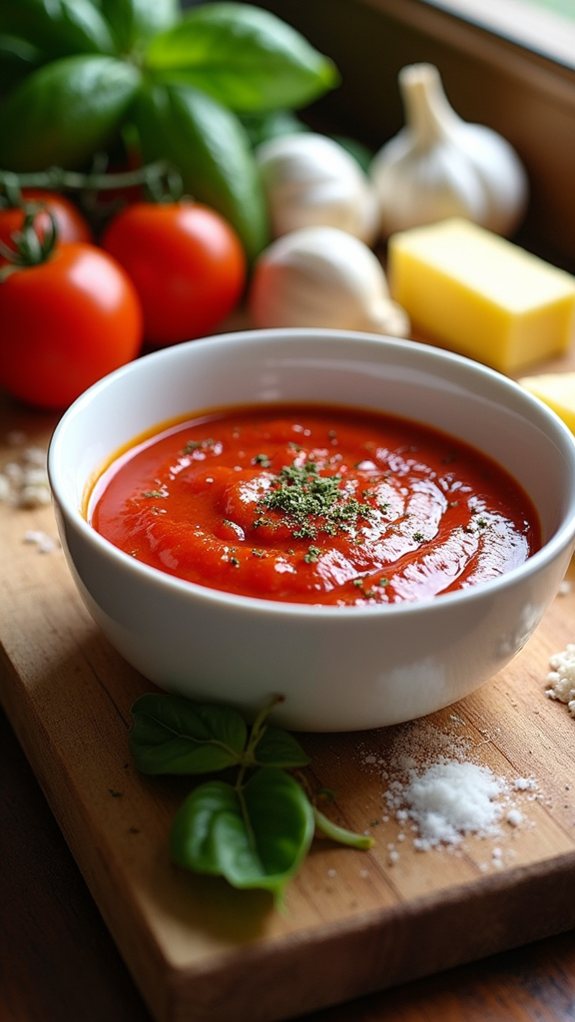
Among the pantheon of pizza sauces, the Classic New York red sauce stands as a cornerstone of American pizza culture, with its rich heritage dating back to the early Italian immigrants who settled in Manhattan's Lower East Side.
This timeless sauce relies on premium San Marzano tomatoes, garlic, and fresh basil to create its signature flavor profile, simmered to perfection with a hint of sweetness from sugar and depth from butter.
- The sauce's hour-long simmer with yellow onion creates layers of complex flavors.
- Its smooth, velvety texture comes from careful blending techniques.
- The final touch of butter adds richness that sets it apart from other pizza sauces.
The sauce perfectly complements the thin yet sturdy crust that has become synonymous with authentic New York-style pizza.
Fresh Basil Pesto Pizza Sauce
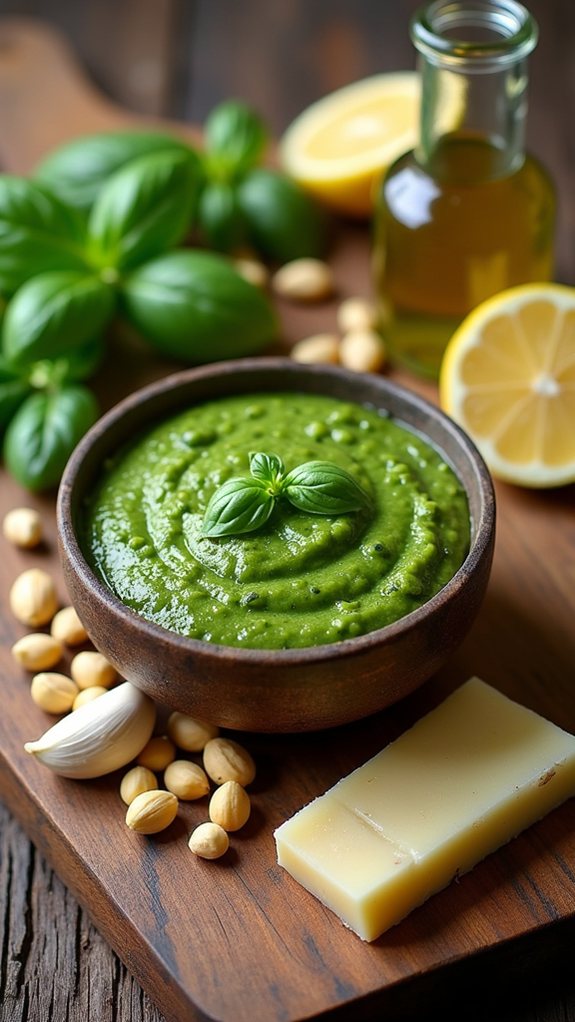
A vibrant alternative to traditional red sauce, fresh basil pesto brings Mediterranean flair and nutty complexity to any pizza creation.
This versatile sauce combines fresh basil leaves, pine nuts, garlic cloves, and high-quality olive oil with freshly grated Parmesan cheese for a robust flavor profile.
The preparation process is remarkably straightforward – simply blend the ingredients until smooth, which typically takes about two minutes.
While traditional recipes call for pine nuts, adventurous pizza makers can experiment with walnuts or almonds as cost-effective substitutes.
A touch of lemon juice brightens the sauce, while optional chili flakes add gentle heat.
For optimal results with pesto sauce, spread it on rolled out dough before adding your favorite toppings and baking at 450°F.
Traditional Neapolitan Tomato Sauce
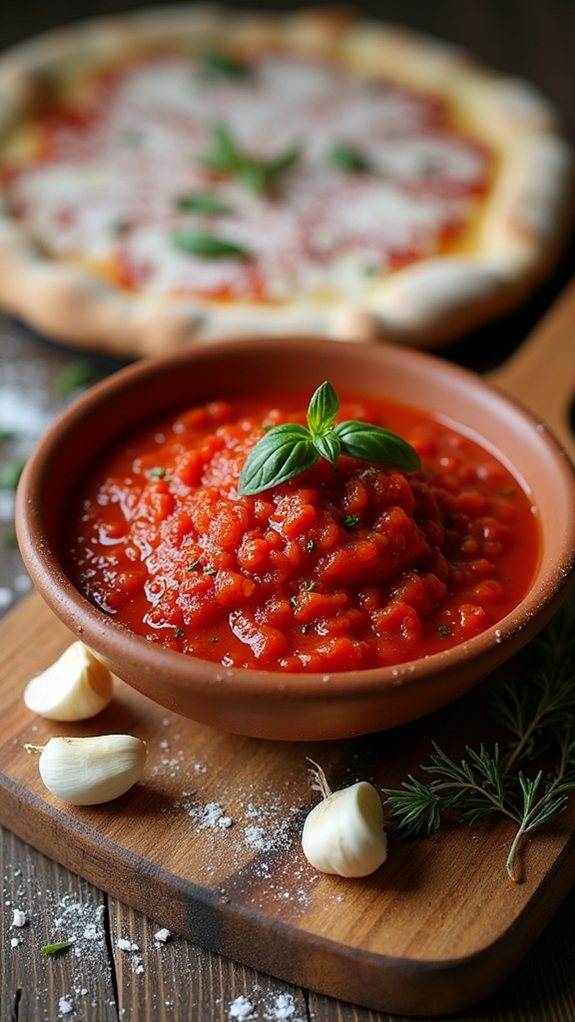
The hallmark of authentic Neapolitan pizza lies in its remarkably simple yet exquisite tomato sauce, which traces its origins back to the pizzerias of Naples, Italy.
Using just San Marzano tomatoes, garlic, salt, and a touch of oregano, this sauce exemplifies the beauty of minimalist cooking.
While other pizza sauces rely on complex spice blends or long cooking times, Neapolitan sauce celebrates the pure, vibrant flavors of its ingredients.
- Requires only 2 minutes of preparation time, allowing more freedom in the kitchen
- Creates an unmistakable taste that transports you to the streets of Naples
- Offers endless possibilities for customization while maintaining its authentic roots
Creamy White Pizza Sauce Recipe
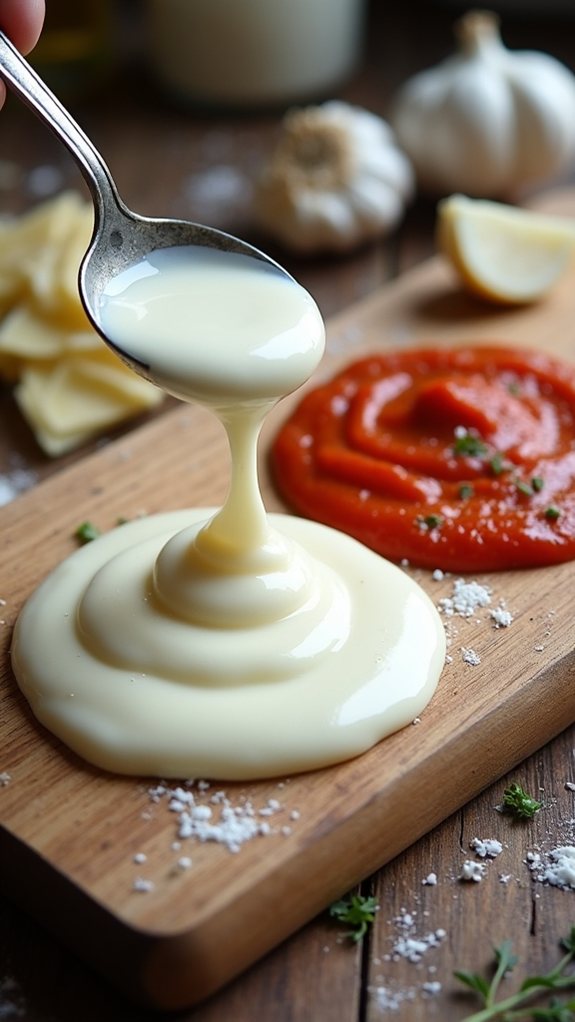
Crafting luxurious white pizza sauce begins with a classic French roux base, transformed into a silky béchamel that serves as the foundation for this adaptable alternative to traditional red sauce. The combination of butter, garlic, and Parmesan creates a rich, creamy texture that pairs beautifully with diverse toppings.
| Technique | Time | Temperature |
|---|---|---|
| Roux Cook | 2-3 min | Medium |
| Milk Add | 5 min | Medium-Low |
| Final Mix | 2 min | Low |
Perfect execution requires careful attention to heat control and continuous stirring, resulting in a velvety sauce that enhances any pizza from ordinary to extraordinary.
FAQs
How Long Can Homemade Pizza Sauce Be Stored in the Refrigerator?
Liquid love for pizzas maintains ideal freshness for up to five days when properly stored in an airtight container. For extended enjoyment, freezing can preserve the sauce for three months.
Can Pizza Sauce Be Frozen for Later Use?
Pizza sauce can be frozen for up to 3 months in airtight containers or freezer bags. When ready to use, thaw overnight in the refrigerator and stir well before applying.
What's the Best Way to Prevent Pizza Sauce From Making Crust Soggy?
A pizzeria owner prevents soggy crusts by draining excess liquid from tomatoes and applying sauce sparingly. Spread a thin layer, avoiding overloading, and consider pre-baking the crust for 2-3 minutes.
Can I Substitute Canned Tomatoes With Fresh Tomatoes in Pizza Sauce?
Fresh tomatoes can substitute for canned ones, but require extra preparation. They should be peeled, deseeded, and cooked longer to reduce water content and achieve proper sauce consistency.
Should Pizza Sauce Be Applied Hot or Cold to the Dough?
Since the days of Julius Caesar's initial pizzeria, pizza sauce should be applied at room temperature to prevent dough from becoming too wet or compromising its structural integrity.
